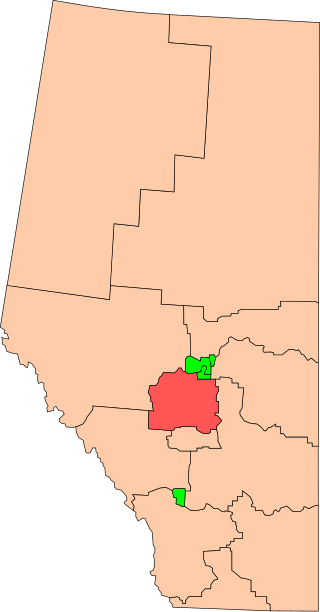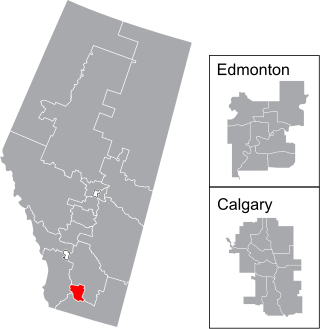
Edmonton Strathcona is a federal electoral district in Alberta, Canada, that has been represented in the House of Commons of Canada since 1953. It spans the south-central part of the city of Edmonton. In the periods 2008–2015 and 2019–2021, during the 40th, 41st, and 43rd Canadian Parliaments, Edmonton Strathcona was the only federal riding in Alberta not represented by the Conservative Party.

Calgary Southwest was a federal electoral district in Alberta, Canada, that was represented in the House of Commons of Canada from 1988 to 2015. The district was in the southwest part of the City of Calgary, south of Glenmore Trail and west of the Canadian Pacific Kansas City Railway line.

Medicine Hat—Cardston—Warner is a federal electoral district in southern Alberta, Canada, that has been represented in the House of Commons of Canada since 1908.

Wetaskiwin was a federal electoral district in Alberta, Canada, that was represented in the House of Commons of Canada from 1925 to 2015.

Calgary Southeast was a federal electoral district in Alberta, Canada, that was represented in the House of Commons of Canada from 1988 to 2015. The district was in the southeast part of the City of Calgary. It was bounded by the city limits to the south and east.

Wild Rose was a federal electoral district in Alberta, Canada, that was represented in the House of Commons of Canada from 1988 to 2015. It had been considered a safe seat for the Conservative Party of Canada.
Calgary East was a federal electoral district in Alberta, Canada, that was represented in the House of Commons of Canada from 1917 to 1953, 1979 to 1988, from 1997 to 2015. It was a lower income urban riding in Calgary, with a sizable visible minority population.

Calgary West was a federal electoral district in Alberta, Canada, that was represented in the House of Commons of Canada from 1917 to 1953, and from 1979 to 2015. It was in the western part of the City of Calgary.

Peace River was a federal electoral district in Alberta, Canada, that was represented in the House of Commons of Canada from 1925 to 2015. It was a rural riding in northwest Alberta, representing Clear Hills County, Saddle Hills County, Birch Hills County, the County of Grande Prairie No. 1, the County of Northern Lights, Mackenzie County, most of Northern Sunrise County, the Municipal District of Fairview No. 136, the Municipal District of Peace No. 135, the Municipal District of Spirit River No. 133, the Municipal District of Smoky River No. 130 and the northern portion of the Municipal District of Greenview No. 16. Following the Canadian federal electoral redistribution, 2012 the riding abolished into Grande Prairie-Mackenzie (72%) and Peace River—Westlock (28%).

Calgary Northeast was a federal electoral district in Alberta, Canada, that was represented in the House of Commons of Canada from 1988 to 2015. It is an urban riding in the city of Calgary.

Calgary Centre is a federal electoral district in Alberta, Canada, that has been represented in the House of Commons of Canada since 1968. The riding consists of many young adults who have a relatively high average household income and education level. As the riding encompasses the downtown core and large swaths of apartment blocks in the communities west and south of downtown, Calgary Centre has a low home ownership rate compared to the rest of Canada.

Edmonton—Spruce Grove was a federal electoral district in Alberta, Canada, that was represented in the House of Commons of Canada from 2004 to 2015. It was a suburban riding in Edmonton.

Lethbridge is a federal electoral district in Alberta, Canada, that has been represented in the House of Commons of Canada since 1917. It incorporates the City of Lethbridge and Lethbridge County.

Macleod was a federal electoral district in Alberta, Canada, that was represented in the House of Commons of Canada from 1908 to 1968 and from 1988 to 2015. It was a mostly rural riding in southwest Alberta, however it extended as far north as the outer suburbs of Calgary, and in its final years included a few slivers of Calgary itself. It covered the Municipal District of Foothills No. 31, Municipal District of Willow Creek No. 26, Municipal District of Pincher Creek No. 9, Municipal District of Ranchland No. 66, Vulcan County, the Municipality of Crowsnest Pass, and Kananaskis Improvement District. It also included the towns of Okotoks, Cochrane, and High River.
Red Deer is a future federal electoral district in Alberta, Canada. A riding of the same name was previously represented in the House of Commons of Canada from 1908 to 2015.

Vegreville—Wainwright was a federal electoral district in Alberta, Canada, that was represented in the House of Commons of Canada from 2004 to 2015.
Battle River was a federal electoral district in Alberta, Canada, that was represented in the House of Commons of Canada at various times from 1914 to 2005.

Rocky View County is a municipal district in southern Alberta, Canada that is named for its views of the nearby Rocky Mountains to the west. It surrounds most of Calgary, forming the city's northern boundary and most of the city's western and eastern boundaries. At a population of 41,028 in 2021, Rocky View County is the most populous municipal district in Alberta. Though predominantly rural in nature, Rocky View County is home to 14 hamlets, including Langdon, one of Alberta's most populous hamlets. Its rural areas are home to numerous country residential subdivisions.

Battle River—Crowfoot is a federal electoral district in Alberta.
Damien C. Kurek is a farmer from Alberta and a Canadian politician who was elected to represent the riding of Battle River—Crowfoot in the House of Commons of Canada in the 2019 Canadian federal election. He was re-elected in the 2021 election.
















